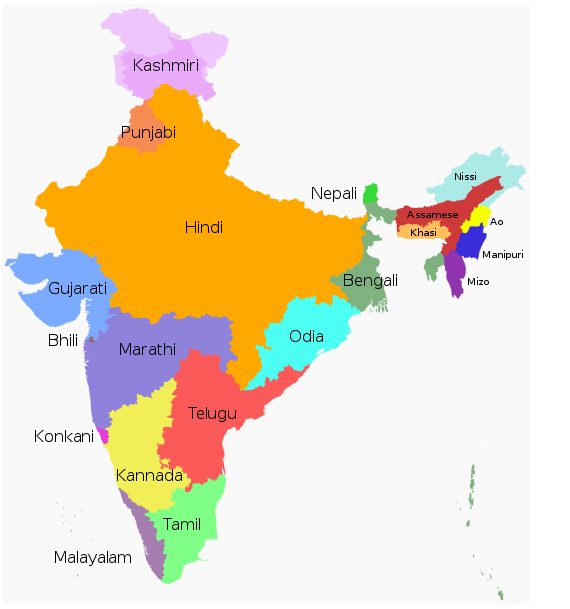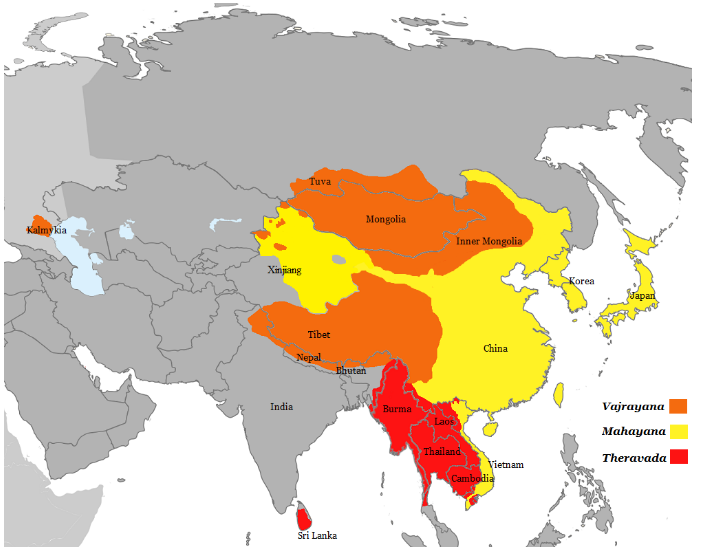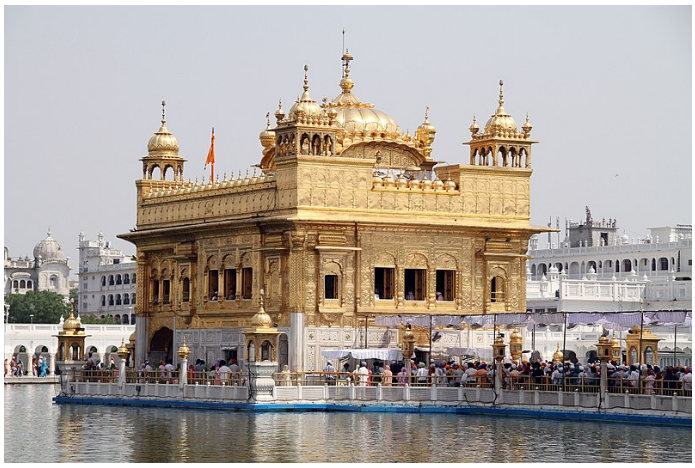8.3: Cultural Groups in South Asia
- Page ID
- 21097
South Asia is a diverse region in terms of its ethnic landscape, culture, and religious beliefs. As shown in Figure \(\PageIndex{1}\), in the northern portion of the region, the Indo-European languages like Hindi dominate as a result of the Aryan invasion. Along the Himalayas, languages in the Sino-Tibetan family dominate. In southern India, however, most groups speak a language in the Dravidian family, comprised of the indigenous languages of South Asia that were present before the arrival of the Aryans. These language families reflect broader differences in culture and ethnicity, including particular religious practices and food customs. Thus the label “Indian cuisine” actually encompasses a diverse array of regional and traditional specialties.

South Asia is a hearth area for several of the world’s great religions. Out of the Aryan invasion of northern India came a religious belief system known as Vedism. The religious texts of Vedism, known as the Vedas, combined with local religious beliefs developed into the modern-day religion of Hinduism by around 500 BCE. Hinduism is a polytheistic religion with a wide variety of individual beliefs and practices. Hinduism is a highly regional and individual religion and its polytheistic nature reflects this open understanding of belief. Of Hinduism’s over 1 billion followers, 95 percent live in India.
At its heart, there are four key features of Hinduism: dharma, karma, reincarnation, and worship. Dharma refers to the laws and duties of being and is different for every person. You might be a student and an employee and a child and a sibling. All of those roles have prescribed responsibilities. To be a good student, for example, means to attend class, read the textbook, and study. In Hindu culture, there are also restraints and observances for how you interact with other people depending on their status.
Hindu views on the afterlife are quite different from the Judeo-Christian conception of heaven. Hindus believe in karma, which means that your deeds, good or bad, will return to you. They also believe in reincarnation, which is the idea that once you die, your spirit is reborn. Thus, you are the sum of numerous past existences. Karma, dharma, and reincarnation go hand in hand. If someone had done good deeds, had good intentions, and lived virtuously, when they die and are reincarnated, they might come back as something great – a prince, perhaps. Conversely, if someone was a terrible person, accumulating an excess of negative karma, when they are reincarnated, they might come back as someone of very low status – or maybe not even a person at all.
Hindu scripture discusses four distinct castes, or groups, of people in society, an example of social stratification. This social hierarchy is known as the caste system. The Brahmins, the highest caste, consist of priests and teachers and represent around 3 percent of India’s total population. There is a warrior caste, a merchant caste, and finally the lowest, the laborer caste of landless serfs. Excluded from this caste system, and viewed as so below it that they are not even a part of it, are the “untouchables,” also known as “Dalit” meaning “oppressed.” The untouchables are so-named because they perform work that makes them spiritually unclean, such as handling corpses, tanning hides, or cleaning bathrooms. Traditionally, higher castes would get ritually purified if they touch a Dalit. Many untouchables are indigenous, non-Aryan Indians.
So how might the belief in karma and reincarnation affect social justice in South Asia? Although the caste system was outlawed by the Indian constitution, widespread discrimination and persecution persists. Many Hindus believe that those in lower castes were reborn into that social status because they had committed misdeeds in their past life. However, other Hindus fought against the caste system and have worked to more fully integrate the Dalits into Indian society.
Buddhism emerged out of Hinduism in northern India following the life and teachings of Hindu prince Siddhartha Gautama. According to Buddhist belief, Siddhartha lived a life of luxury, but became disenchanted with his life of privilege when he was faced with society’s injustices, such as illness and extreme poverty. Since Hinduism offered no clear cessation of what Siddhartha viewed as an endless cycle of suffering through samsara, the soul’s continual death and rebirth, he sought out new ways of ending suffering. For a time, Siddhartha practiced meditation and extreme asceticism, eating only dirt and bits of rice. But neither the path of luxury nor the complete absence of worldly pleasures gave him the insight he sought. Eventually, Siddhartha, in meditation under a Bodhi tree in Bodh Gaya, India, discovered what Buddhists refer to as the Middle Way, a path of moderation. He is said to have achieved enlightenment and is known as the first Buddha, meaning “awakened one.”
Although Buddhism, like Hinduism, is a highly regional religion with many different forms of individual expression, Buddhists generally share a belief in the Four Noble Truths: 1) Suffering is universal and inevitable, 2) The immediate cause of suffering is desire and ignorance, 3) There is a way to dispel ignorance and relieve suffering, and 4) The eightfold path is the means to achieve liberation from suffering. Buddhists also share with Hindus a common belief in karma, dharma, and reincarnation.
Buddhism diffused across Asia, though never taking a strong hold in India (Figure \(\PageIndex{2}\)). The Maurya Emperor Ashoka, in particular, was responsible for the widespread diffusion of Buddhism in the 3rd century BCE. The religion has three primary branches, each with a distinct regional concentration. The oldest branch, Theravada, is primarily practiced in Southeast Asia, in places like Cambodia, Laos, Myanmar, and Thailand and is also the majority religion on the South Asian island of Sri Lanka. Mahayana is practiced by most Buddhists worldwide, particularly in places like China and Japan. Vajrayana Buddhism, which is sometimes considered a subset of Mahayana Buddhism, is practiced in the Himalayas and Tibetan Buddhism is a notable example. Buddhism has around 500 million followers worldwide.

Although Buddhism and Hinduism are the most widely practiced, South Asia was also a hearth area for the Jain and Sikh religions. Jainism emerged in India in the first century BCE and emphasizes ahimsa, nonviolence toward all living beings. Even insects found in the home are gently ushered out rather than killed. Jains also seek to break free from attachments and inner passions, and aim to keep an open mind toward different perspectives. The teachings of Jainism were influential for Gandhi and his emphasis on nonviolent resistance.
Sikhism emerged in the Punjab region of northwestern India and northern Pakistan in the 15th century. It is a monotheistic religion founded on the teachings of Guru Nanak that combines elements of both Hinduism and Islam. Like Hindus, Sikhs believe in reincarnation and karma. But unlike Hinduism, Sikhism prohibits the worship of idols, images, or icons. Sikhs believe God has 99 names, an adaptation of Hindu polytheistic belief. Sri Harmandir Sahib, commonly called the “Golden Temple,” in Amritsar, India is the holiest Sikh temple, which are called gurdwara (Figure \(\PageIndex{3}\)). However, the building is open to everyone and every visitor is offered a free meal. Over 100,000 people visit the site every day.

These religions, along with other minority religions like Christianity and indigenous belief systems, have not always coexisted peacefully in South Asia. Although India is officially secular, having no official religion, regional religious conflicts have often occurred throughout history. The difficulty is that in this region, very few people actually are secular, with no attachment to religion. Governments have thus struggled to find ways of accommodating minority religious groups while not offending the majority.
- Hinduism:
-
an ancient polytheistic religion that first developed in South Asia and is characterized by a belief in karma, dharma, and reincarnation
- Social stratification:
-
a system of social categorization where people in a society have differing levels of social status
- Caste system:
-
a form of hereditary social hierarchy found in Hinduism
- Buddhism:
-
religion that emerged from Hinduism and is based on the teachings of Siddhartha Gautama
- Jainism:
-
a religion emerged in India in the first century BCE and emphasizes ahimsa, nonviolence toward all living beings
- Sikhism:
-
a monotheistic religion founded on the teachings of Guru Nanak that combines elements of both Hinduism and Islam


